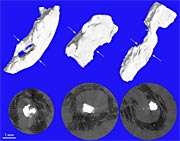Mapping atherosclerotic arteries: Combined approach developed

A new method allows calcified and constricted blood vessels to be visualized with micrometer precision, and can be used to design containers for targeted drug delivery. Within the project "NO-stress", materials scientists from the Medical Faculty of the University of Basel combined cutting-edge-imaging techniques to visualize and quantify the constrictions caused by atherosclerosis.
Cardiovascular diseases, including atherosclerosis, are associated with plaque formation and the most prevalent cause of death worldwide. Unlike vessels and other soft tissues, the plaque formed provides strong contrast in X-rays, as known from bone. So far, it has therefore been difficult or even impossible to identify soft tissues in the direct neighborhood of calcifications using X-rays.
A team of researchers from laboratories in three European countries, led by Bert Müller (Biomaterials Science Center at University of Basel), has developed a protocol that is based on the combination of hard X-ray tomography and established histology methods, to visualize the vessels constricted by atherosclerosis. The data about the morphology of the constricted vessels is used to simulate blood flow and determine related shear stresses. The shear stress is significantly enhanced at the constrictions and forms the basis for the development of specialized nano-containers for the targeted and local delivery of vasodilation drugs.
Differentiation between soft and hard tissues
The new method combines known approaches and is not only suitable for the three-dimensional characterization of atherosclerotic blood vessels but also for any other combination of strongly and weakly X-ray absorbing species including cartilage and bone. It takes advantage of conventional X-ray absorption and, in addition, of X-ray phase contrast measurements, which are for example accessible via grating interferometry. As the phase contrast is much less dependent on the atomic number of the constituents than the absorption contrast, the soft tissues in the vicinity of hard tissues become much more easily visualized.
In summary, the authors demonstrate that strongly calcified arteries are thoroughly characterized by the combination of the non-destructive tomography measurements in X-ray absorption and phase contrast modes, and established histology techniques. The project "NO-stress" is funded within the National Research Programme NRP 62 "Smart Materials" by the Swiss National Science Foundation.
More information: Margaret N Holme, Georg Schulz, Hans Deyhle, Timm Weitkamp, Felix Beckmann, Johannes A Lobrinus, Farhad Rikhtegar, Vartan Kurtcuoglu, Irene Zanette, Till Saxer, Bert Müller, Complementary X-ray tomography techniques for histology-validated three-dimensional imaging of soft and hard human tissues, Nature Protocols 9, 1401-1415. DOI: 10.1038/nprot.2014.091





















